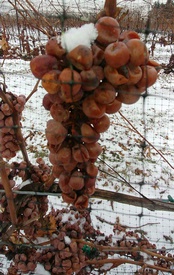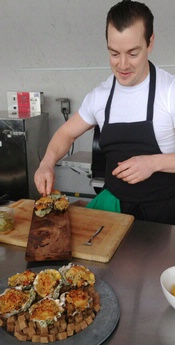Many of the great sweet wines of the world are made by various methods of dehydration which concentrates the natural sweetness of the grape. The grapes can be harvested late, dried on or off the vine, infected by the noble rot--botrytis, or frozen. All these methods can be tricky, requiring the utmost grower attention to avoid unwanted effects. Perhaps the most difficult sweet wine to make is ice wine. Yes, it’s just like it sounds: Wine made from icy, that is, frozen grapes.
The origin of ice wine is hazy, but in many accounts, monks in Franconia in the 1700s get credit for making the first post-Roman ice wine. You can imagine that having found their year’s work in the vineyard turned into grape-cicles, they would be determined to somehow to make wine. More recently in the 1960s, Dr. Hans Ambrosi, director of the Rheingau State Vineyard in Eltville, has been called the Father of Eiswein for his research and understanding of the process, which he shared with winemakers.
True ice wine is made from grapes frozen on the vine. Icewine is a term trade-marked by the Canadian Vintners and Eiswein is an official German classification. Some producers make ice wine, by first harvesting, then freezing the grapes. In the U.S. it is not legal for wines made this way to be called ice wine. The TTB’s regulation states “Wine made from grapes frozen after harvest may not be labeled with the term “ice wine” or any variation thereof, and if the wine is labeled to suggest it was made from frozen grapes, the label must be qualified to show that the grapes were frozen post-harvest.”
Several countries make ice wine today, including Austria, Germany, Canada, U.S. and China. Canada produced its first ice wines in the 1970s in British Columbia and in the 1980s in Ontario, but today it, along with Germany, dominates the world production. In Canada, Ontario produces 90 percent of the country’s ice wine. I recently visited Niagra-on-the-Lake as a guest of Arterra Wines Canada, to learn more about this region’s wines and to attend the Icewine Village Street Festival.
Icewine production is regulated by the Ontario VQA (Vintners Quality Alliance). Their rules state that grapes may be harvested when there is a sustained temperature of -8˚C and a minimum Brix of 35. Depending upon weather, that may be as early as November or as late it as January or even February. The grapes may hang longer than required based upon the

winemaker’s decision. The vines are covered with bird netting, because as Bruce Nicholson, winemaker at Inniskillin, said, “When it snows the birds are ravenous. They will take everything!” The netting is closed at the bottom with clips to catch grapes that fall off the vines. As the season goes on, the pile of fallen grapes begins to resemble a sausage and the local wisdom is that you must open the net at the bottom to gather the sausage before picking the grapes.
Nicolson explains that, as a grower waiting to harvest frozen grapes, “You can’t go anywhere because you don’t know when you will be able to pick.” Most harvesting is done at night. Some growers hand harvest, which means they need to have a picking crew on standby. It is certainly cold and arduous work. We had “the opportunity” to harvest grapes and spent maybe 20 minutes in the vineyard with clippers. That was about ten minutes longer than fun. I have the utmost respect for those pickers. Thank goodness Inniskillin’s Estate Chef Timothy Mackiddie had a cup of Cabernet Franc Icewine-spiked Valrona hot chocolate ready for us when we finished to help us warm up. More below on his wine and food pairings and how he uses Icewine in recipes.
Many wineries now machine harvest, which certainly solves the problem of finding a picking crew. The machine can gather the grapes with the netting in place. Nicolson noted that the grapes are not damaged since they are frozen.
We watched as the winery crew crushed newly harvested grapes in a basket press. Very little liquid was expressed from the grapes. Approximately 80% of the water content in the grapes remains frozen as ice crystals, which puncture the skins for added flavors. From there the juice goes into tanks

where yeasts are added to start the fermentation. They don’t use indigenous yeasts since, as Nicholson explained, there are no live natural yeasts in vineyards in the snow.
According to
Wine Grapes, by Robinson et al, Vidal Blanc is a hybrid grape bred from a vinifera variety, Ugni blanc, a.k.a. Trebbiano Toscana, and a hybrid variety, Rayon d’Or. It has a thick skin and is cold hardy, which makes it a perfect candidate for Icewine. Producers may pick more thin-skinned varieties like Riesling or Cabernet Franc as soon as required Icewine conditions are met. Nicholson said that Riesling is one of the first grapes they take off the vine. One of the reasons he likes Riesling for Icewine is its great acidity. “It’s all about balance,” said Nicolson. “If Icewine is not balanced, it’s just sugar water. Acidity is the skeleton.”
Vidal Blanc is left on the vine much longer and may thaw and refreeze a few times before it is harvested, which will further dehydrate the grape. Nicholson likes the grape for its thick skin and ability to maintain acidity. We tasted 2017 Vidal Icewine, Niagara Penninsula VQA ($84 for 375ml) which displayed vibrant pineapple, mango flavors with a whisper of fresh herbs. It was rich and velvety in the mouth with mouthwatering acidity that buoyed the voluptuous sweetness. The 2017 Gold Vidal Icewine, Niagara Penninsula VQA, was fermented in new French oak and aged an additional four months in oak ($94 for 375ml). It offered rich peach and pineapple flavors enhanced with baking spice aromas, concentrated and lush in the mouth, yet lively with bright acidity. Riesling Icewine, Niagara Penninsula VQA 2017 ($84) had gorgeous aromas of orange zest and caramelized apple with floral notes. It was rich and viscous in the mouth with brilliant acidity that cleansed the palate and left it begging for more. Inniskillin wines are imported to the U.S. by Constellation.
Chef Tim demonstrated that Icewine can go well with savory, as well as, sweet foods. A decadent appetizer he served with Gewurztramier Icewine was a juicy chunk of Atlantic lobster on a grapevine skewer. He froze a foie gras

torchon so he could grate it over the lobster. He prepared dark chocolate beef chili, a riff on Mexican mole that was served with Vidal Icewine. He served smoked pork belly with kimchi on a bao bun. At another meal he presented smoked beef short ribs with a caramelized onion gratin with Cabernet Franc Icewine. He makes sauces, syrups and flavored butters with Icewine. So, he uses sumptuous and silky foie gras, or the rich, fatty texture of pork belly to complement the sweetness and richness of the wine, and he uses spicy, smoky flavors to contrast.
Yes, Icewine is expensive, but maybe not when you consider what it takes to produce it. The wine is so rich, that it’s a good idea to a serve small, well chilled portions in a generous-sized white wine glass. If you don’t finish a bottle the day it’s opened it, put the cork back in and store it in the fridge. It will retain its freshness for a couple of weeks, easily. If you think it’s been in the fridge too long…use it to make a delicious sauce or syrup!